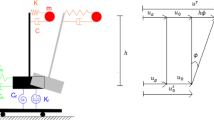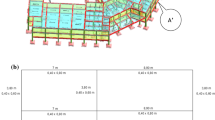Abstract
The paper focuses on methods for dynamic analysis used in modern construction. The real object located in the Comintern district of Odessa region is taken as an example. When the earthquake loads are simulated, the authors use real accelerograms that were taken during the earthquake at the construction site of the object. For this construction site, several accelerograms were generated; they simulate 7 units of magnitude earthquakes from Vrancha zone and local focal zones. Analysis is carried out with obtained three-component accelerograms by the method of spectral analysis, and direct dynamic analysis was carried out. Described technique enables the user to simulate behaviour of the structural system of a building based on the finite elements developed and implemented in LIRA-SAPR program; these finite elements simulate vibration damping, to remedy the shortcomings of spectral and direct dynamic analyses. It also enables the user to solve physically nonlinear problems with soil and do not significantly increase the size, and respectively, time for analysis of the problem.
Access provided by Autonomous University of Puebla. Download conference paper PDF
Similar content being viewed by others
Keywords
1 Introduction
To provide the safety of buildings and structures in earthquake loads, new methods of earthquake-resistant design [1, 2] are developed based on computer simulation of structures’ behaviour in future earthquake loads [3]. Such methods take into account building codes of different countries, specific aspects of earthquake-resistant construction, and soil properties.
When behaviour and reaction of building structures to earthquake loads are simulated, it is necessary to take into account many factors, such as distance from the earthquake focus (hypocenter), 3D behaviour of the structure, interaction with the soil, account of physical nonlinearity [4], etc.
Seismic areas with predicted intensity of earthquake as 7, 8 and 9 units of magnitude occupy up to 20% territory of Ukraine. There are many industrial and cultural centres there; the active construction is often underway. It is highly important to design the earthquake-resistant structures in the rational manner, to improve their reliability and structural safety. Seismic sustainability of buildings [5] erected in the seismic regions of Ukraine shows that the actual earthquake loads on the building significantly exceed design loads that were stipulated in regulatory documents.
2 Purpose
Due to analysis of the system ‘overground structure – foundation – soil’, it is possible to consider the pressure of the soil space on the stress-strain state of the whole building. As a rule, numerical solution of problems based on the FEM involves a limited finite soil region. The question is how to correctly model the infinite half-space of the soil and define boundary conditions to consider the real damping properties of soil [6]. When the earthquake loads are simulated, boundary conditions should provide damping and infinite wave propagation through the soil.
There are two general approaches to model the soil-structure interaction in dynamic analysis. The essence of the direct method is that the soil area is cut off quite far from the building and rigid boundary conditions are imposed.
3 Method
The method of substructures (SBFEM) was proposed by John Wolf [7]. This method is based on the conversion from the Cartesian coordinate system X, Y (in 2D problem) to the isoparametric coordinates ξ, η. Geometry of the region is described by scaling the boundary with the dimensionless radial coordinate ξ that starts from the scaling centre (point O) to the point on the boundary. ξ = 0 at the point O and ξ = 1 at the boundary (Fig. 1). The SBFEM method is more accurate than the direct method, so the simulated area may be smaller than for the direct method. As a rule, in this method, the exact boundary conditions are expressed in a dynamic stiffness matrix \( [S(t)^{\infty } ] \).
Along the radial line drawn from point O to the node at the boundary, a nodal displacement function is introduced and the equation of displacements is composed.
where \( [E^{0} ] \), \( [E^{1} ] \), \( [E^{2} ] \) and \( [M^{0} ] \) matrices with coefficients.
Connection between the two parts of the soil is provided by the interaction vector
Where \( [M^{\infty } (\tau )] \) - acceleration unit-impulse response matrix, determined as
where \( [m^{\infty } (\tau )] \) acceleration unit-impulse response matrix in transformed coordinates, \( [e^{1} ] \), \( [e^{2} ] \) and \( [m^{0} ] \) matrices of coefficients, \( H(t) \) - Heaviside step function.
Based on Eq. (1) and Eq. (2), the finite elements [8] were developed and implemented in LIRA-SAPR software. These elements simulate interaction between the limited part of soil and the rest part of the half-space: 2-node FE for solving 2D problem, 3-node and 4-node FE - to solve 3D problems.
Spectral analysis of earthquake load is usually carried out. The serious shortcoming of this approach is that it is not possible to take into account physical nonlinearity and the soil.
The paper describes technique for simulation and dynamic analysis; this technique could remedy the shortcomings of the spectral method.
4 Numeric Test
The model of real building is considered; the building is located in the Comintern district of Odessa region, it is considered as seismically dangerous and seismically active zone of Ukraine. The focuses of the most severe earthquakes are located in Vrancha zone and in Dobrudji region at a distance of up to 300 km from the construction site.
For this construction site, several accelerograms were generated; they simulate 7 units of magnitude earthquakes from Vrancha zone and local focal zones (Fig. 2).
Based on the data [9], 3D computer model of 13-storey building was generated in the LIRA-SAPR program (Fig. 3). Analysis is carried out with obtained three-component accelerograms by the method of spectral analysis, and direct dynamic analysis was carried out [10].
Let us compare results of displacements along the X-axis obtained in spectral method (Fig. 4) and max displacements obtained in the direct dynamic method (Fig. 5). There is a significant difference in the stress-strain state of the structure.
However, it should be mentioned that max displacements of the system in analysis by direct dynamic method occur after the end of load action. The load lasts 41 s, and max displacements are achieved at 49.6 s. This is because when seismic wave reaches the boundary of FE model, it is reflected from the boundary and returns to the structure. This is clearly visible on the graph of displacements for the node (126511) (Fig. 6) of the last storey (Fig. 7) and on the graph of kinetic energy of the system (Fig. 8). After the end of the load action, the energy does not decrease and even tends to increase.
The results indicate that the system does not work properly. At the end of the load action, instead of kinetic energy attenuation, the energy increases. To eliminate such an unacceptable effect, new FEs were developed in LIRA-SAPR program; they simulate unbounded substructure. When such FEs are applied at the boundary of soil model, displacements correspond to the amplitude values of applied accelerogram (Fig. 9 and 10). Moreover, in Fig. 11 we see that kinetic energy of the system decays when dynamic load is ended, which is natural.
5 Conclusions
Described technique enables the user to simulate behaviour of the structural system of a building more accurately, to simulate vibration damping, to remedy the shortcomings of spectral and direct dynamic analyses. It also enables the user to solve physically nonlinear problems with soil and do not significantly increase the size, and respectively, time for analysis of the problem.
Together with the technique of seismic microzoning, described technique enables the user to simulate adequate behaviour of buildings and structures in earthquake loads in order to evaluate the seismic resistance.
References
Birbraer, A.N.: Raschet konstruktsiy na seysmostoykost. Nauka, St. Petersburg, 255 p (1998)
Clough, R., Penzien, J.: Dinamika sooruzheniy. Stroyizadt, Moscow, 320 p (1979)
Barabash, M.S., Kostyra, N.O., Pysarevskiy, B.Y.: Strength-strain state of the structures with consideration of the technical condition and changes in intensity of seismic loads. IOP Conf. Ser. Mater. Sci. Eng. 708, 11 (2019)
Fomin, V., Bekirova, M., Surianinov, M., Fomina, I.: Nonlinear dynamic analysis of a reinforced concrete frame by the boundary element method. In: Materials Science Forum 6th International Conference “Actual Problems of Engineering Mechanics” (APEM 2019), vol. 968, pp. 383–395 (2019). ISSN:1662-9752
Dorofeev, V.S., Egupov, K.V., Egupov, V.K.: Methods to evaluate the seismic resistance of buildings and structures. Publishing ONMU (Odessa National Maritime University), Odessa, 164 p (2019)
Barabash, M., Pisarevskyi, B., Bashynskyi, Y.: Taking into account material damping in seismic analysis of structures. Tech. J. 14(1), 55–59 (2020)
Wolf, J.P.: The Scaled Boundary Finite Element Method. Wiley, Chichester, 364 p (2003)
Gorodetsky, A., Pikul, A., Pysarevskiy, B.: Modelirovanie raboti gruntovih masivov na dinamicheskie vozdeystviya. Int. J. Comput. Civil Struct. Eng. 13(3), 34–41 (2017)
Egupov, K.V.: Opredelenie sejsmicheskoj opasnosti ploshhadki stroitel’stva mnogokvartirnogo chetyrehsekcionnogo 14-ti jetazhnogo zhilogo doma so vstroenno-pristroennymi pomeshhenijami social’nogo naznachenija i so vstroenno-pristroennym podzemnym parkingom po adresu: s. Kryzhanovka, ul. Marsel’skaja, Odesskaja oblast’ – po dannym sejsmicheskogo rajonirovanija i generirovanija raschjotnyh akselerogramm. Odessa, 79 p (2017)
Pikul, A.V., Barabash, M.S.: Problemy modelyuvannya dynamichnykh vplyviv. In: Realizatsiya v PK LIRA-SAPR. Collection of paper abstracts from the International Scientific and Technical Conference devoted to the 90th anniversary of the birth of prof. Yehupov V.K. ‘Earthquake engineering in theory and practice’, 124 p, ODABA, Odesa, (2016)
Author information
Authors and Affiliations
Corresponding author
Editor information
Editors and Affiliations
Rights and permissions
Copyright information
© 2021 Springer Nature Switzerland AG
About this paper
Cite this paper
Barabash, M., Iegupov, V., Pysarevskyi, B. (2021). Simulation of the Seismic Resistance of Buildings with Account of Unlimited Soil Space. In: Blikharskyy, Z. (eds) Proceedings of EcoComfort 2020. EcoComfort 2020. Lecture Notes in Civil Engineering, vol 100. Springer, Cham. https://doi.org/10.1007/978-3-030-57340-9_4
Download citation
DOI: https://doi.org/10.1007/978-3-030-57340-9_4
Published:
Publisher Name: Springer, Cham
Print ISBN: 978-3-030-57339-3
Online ISBN: 978-3-030-57340-9
eBook Packages: EngineeringEngineering (R0)















